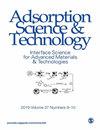活性氢氧化钾-三叶草废弃物生物吸附剂去除孔雀绿的特性、动力学、等温和热力学研究
IF 3.2
4区 工程技术
Q2 CHEMISTRY, APPLIED
引用次数: 22
摘要
尽管已经探索了几种从水中和整个环境中去除染料和其他有毒物质的方法,但研究人员/科学家仍在追求新型、低成本和环保的生物吸附剂,以有效去除这些污染物。在此,丁香叶(CL)被用作从水溶性溶液中螯合孔雀石绿(MG)的生物吸附剂。随后使用氢氧化钾(KOH)活化CL,并使用FTIR和FESEM进行表征,以确定活化丁香叶(CL-KOH)上的官能团和吸附剂的形态。观察到MG的吸附相对依赖于所用吸附剂的剂量、初始MG浓度和吸附过程接触时间。MG对CL的吸附过程使用Dubinin–Radushkevich和Elovich模型进行了理想描述,最大吸附容量约为131.6 mg·g-1。此外,计算的热力学参数表明,mg在吸附剂上的吸附是放热的,过程包括物理吸附和化学吸附,吸附能可忽略不计。总之,该研究表明,CL是一种成本效益高的生物吸附剂,具有从水溶性溶液中螯合MG的高吸附效率,并且可以回收用于进一步使用。本文章由计算机程序翻译,如有差异,请以英文原文为准。
Malachite Green Removal by Activated Potassium Hydroxide Clove Leaf Agrowaste Biosorbent: Characterization, Kinetic, Isotherm, and Thermodynamic Studies
Although several approaches have been explored for the removal of dyes and other toxic materials from water as well as the entire environment, notwithstanding, researchers/scientists are still pursuing novel, low-cost, and eco-friendly biosorbents for the effective removal of such contaminants. Herein, clove leaves (CL) were utilized as a biosorbent for the sequestration of malachite green (MG) from a water-soluble solution. The CL was subsequently activated using potassium hydroxide (KOH) and characterized using the FTIR and FESEM to determine the functional groups on the activated clove leaves (CL-KOH) and the morphology of the adsorbent. The adsorption of MG was observed to be relatively dependent on the dosage of sorbent utilized, initial MG concentration, and sorption process contact time. The adsorption process of MG to CL was ideally described using the Dubinin–Radushkevich and Elovich models with the determination of maximum sorption capacity of approximately 131.6 mg·g-1. Furthermore, the thermodynamic parameters calculated showed that the adsorption of MG to the adsorbent was exothermic with the process involving physical sorption as well as chemical sorption processes with negligible adsorption energy. In conclusion, the study has revealed that the CL is a cost-effective biosorbent with high adsorption efficiency for the sequestration of MG from a water-soluble solution and can be recycled for further usage.
求助全文
通过发布文献求助,成功后即可免费获取论文全文。
去求助
来源期刊

Adsorption Science & Technology
工程技术-工程:化工
CiteScore
5.00
自引率
10.30%
发文量
181
审稿时长
4.5 months
期刊介绍:
Adsorption Science & Technology is a peer-reviewed, open access journal devoted to studies of adsorption and desorption phenomena, which publishes original research papers and critical review articles, with occasional special issues relating to particular topics and symposia.
 求助内容:
求助内容: 应助结果提醒方式:
应助结果提醒方式:


